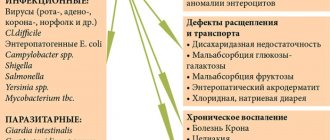As your baby gets older, new causes of constipation may appear. The child begins to eat with adults, and his taste preferences are formed. Quite early, children begin to abuse not very healthy products (for example, sweets). Preschoolers and schoolchildren prefer chips, candies, sweet carbonated drinks and eat vegetables and fruits less and less. Poor diet in children in most cases leads not only to constipation, but also to more serious gastrointestinal diseases1.
In addition to poor nutrition, the causes of the problem of constipation are also psychological factors associated with changes in the social status of the child. In kindergarten or at school, most children are embarrassed to use the toilet and wait until they get home, and this can lead to constipation1.
Why might a child be constipated?
In infants, nutrition is an important factor in normal bowel function. Typically, formula-fed babies have half as many trips to the toilet as breastfed babies. It should be remembered that a small person has not yet developed mechanisms for regulating digestion. Therefore, any change in diet can lead to intestinal dysfunction, including constipation. It is advisable that the baby be fed breast milk for at least 6 months; complementary foods (juices, purees, cereals, fermented milk products, cottage cheese) should not be introduced until 5-6 months; frequent changes of food, especially the main diet, are extremely undesirable (for example, if the baby receives some kind of artificial mixture, you should not try to replace it with another unless there is a clear need for it)2.
Constipation is often accompanied by intestinal dysbiosis. Disturbances in the composition of normal (functional) intestinal flora occur for various reasons. Any problems during pregnancy, such as the threat of miscarriage, toxicosis, infectious diseases, taking antibiotics or hormonal drugs, hidden and sluggish chronic diseases in a pregnant woman, can cause dysbiosis in the baby. Other reasons are also possible: caesarean section, premature birth, infection of the child and poor nutrition (early transition to formula milk, late introduction of complementary foods, lack of nutritional stability)3.
Nutrition as a regulator of intestinal motor function retains its role in older children (4 years and beyond). Long-term consumption of crushed and heat-treated food products (mashed potatoes, jelly, liquid porridges and others), the absence of foods containing coarse fiber or fiber in the diet can cause constipation4.
Eating high-calorie foods even in small quantities (caviar, chocolate, flour products) can also contribute to constipation. Strong tea, cocoa, cottage cheese, rice, pomegranates, pears, quince, astringent products and the above-mentioned chocolate, baked goods have a fixing effect5,6.
The cause of constipation in children can be muscle hypotonia (muscle weakness) and physical inactivity (sedentary lifestyle). In infants, muscle weakness can develop due to poor nutrition (low birth weight) or rickets3. Muscle hypotension (“sluggish” muscle work) in older age is a consequence of physical inactivity7.
Psycho-emotional stress can also provoke functional constipation in a child over 1 year old. Any psychological trauma can lead to the development of chronic constipation in a child. It can be caused by the death of a beloved animal, excessively harsh punishment, severe fear, conflicts with peers and adults. Adolescent schoolchildren aged 10 years and older often experience bowel retention due to the fact that they suppress the urge to defecate, are afraid of being distracted from the lesson, or are embarrassed to go to the toilet “in a big way” at school6.
Information about the drug and indications for use
Newborns often suffer from tummies
The drug, which stimulates bowel function, is available in the form of a syrup that can be added to both water and breast milk. The main active ingredient is lactulose - it allows you to activate the natural intestinal microflora. In addition, the drug helps soften stool, preventing the absorption of liquid.
It also removes toxins and ammonium salts from the body, which can cause constipation. Duphalac stimulates intestinal peristalsis: the walls begin to contract more actively, ensuring the excretion of feces. However, this drug has an important feature: the therapeutic effect does not occur immediately, but only within 24 hours after use. If constipation has been a problem for a long time, you should use other medications prescribed by your doctor.
In addition, Duphalac is not prescribed for chronic constipation; in this case, a comprehensive restoration of digestive functions is required. Main indications for use:
- Disturbance of the physiological rhythm in the functioning of the colon. Often constipation is a consequence of switching from breast milk to formula or deviations in feeding regimen. It cannot be left unattended so that problems with intestinal function do not become chronic.
- Dysbacteriosis, which in young children is usually a consequence of poisoning or taking potent drugs. Duphalac makes it possible to restore the normal functioning of the microflora.
- Pathologies in the liver, enteritis, dyspepsia and other diseases of the digestive tract. In such cases, the dosage is set only by the attending physician; self-medication is unacceptable. Hepatic encephalopathy can lead to serious consequences.
Duphalac is not prescribed for intestinal obstruction - in this case, other methods are used, including surgical ones.
Also a contraindication is high sensitivity to lactose, fructose, galactose and other components of the drug. Duphalac should also not be used for diabetes mellitus, lactase deficiency and some other digestive disorders.
What types of constipation are there?
Stool retention can be caused by congenital anatomical defects of the colon and rectum. Constipation in children, the causes of which lie in anatomical features, is called organic.
In the vast majority of cases in childhood, not organic, but functional constipation occurs. Functional constipation is not caused by structural lesions of the intestine (everything is formed correctly, there are no anatomical defects of the intestine), but by violations of the mechanisms regulating the motor activity of the gastrointestinal tract (dysfunction of the gastrointestinal tract)1.
As a result of various reasons, the tone of the intestinal wall changes. Constipation can be spastic (more details in a separate article), when the tone of some part of the intestine is increased, and feces cannot pass through this place. With such constipation in a child over 1 year of age, the feces become very dense, “sheep-like.” Another type of functional fecal retention in children 5, 6, 7, 10 years old is hypotonic or atonic constipation. In this case, the delay in defecation can reach 5–7 days, the feces are usually large in volume, but loose8.
What is considered constipation in a child?
Constipation in a child should be considered difficulty in defecation (the process of bowel movement) or the absence of self-emptying of the intestines for a certain period of time. Depending on the age of the child, the timing during which the act of defecation must occur may vary. The task of parents is to control this process9.
A breastfed newborn will have a bowel movement after virtually every meal. This is an ideal option, but for children under 2–3 months, stool is allowed at least 2 times a day. When bottle-fed, constipation in a child under one year of age should be considered the absence of independent bowel movements during the day10. In this case, something needs to be done to alleviate the baby’s condition.
In children under 6 months, stool retention is considered not only the absence of spontaneous bowel movements during the day, but also the appearance of hard and formed feces. The normal consistency of stool at this age is “porridge,” that is, unformed (but not watery) stool. If a baby under six months old has “sausage” or “ball” stool, diagnosis and treatment are necessary. At the age of 6 months to 1.5 years, stool may be pasty11.
Constipation in a child of 2, 3, 4 years old can be expressed in the fact that he is forced to strain hard during bowel movements, the stool comes out with a very hard consistency in the form of “nuts”, in small portions, often streaked with blood5.
In children of preschool and primary school age (6–7 years), constipation is the act of defecation less than 2 times a week. Defecation is painful or difficult, and there may be one episode of fecal incontinence per week. Children may pass loose or pasty stools if a fecal plug has formed and passed. This is called “constipative diarrhea”6.
Parents may suspect constipation in a high school student if the child goes to the toilet with a book or phone and remains there for a long time. In this case, you need to talk to him, since teenagers are often embarrassed to tell their parents about their problems with bowel movements12.
For some people (according to various sources, there are about 3–10%), defecation once every 2–3 days is normal. At the same time, they have an uncomplicated act of defecation, stool of normal consistency and its retention does not cause any unpleasant sensations (such as lethargy, a feeling of heaviness or fullness in the abdominal cavity, abdominal pain, loss of appetite). These features of the gastrointestinal tract are usually inherited. But at 5–12 years old, a child should visit the toilet with a frequency typical for his age—4–9 times a week6.
Signs your child is ready for potty training
To make this process easy and without discomfort, Komarovsky advises observing the baby for a while to detect signs of his readiness to learn. They should be both physiological and psychological. It's time to start potty training if:
- the baby can communicate in a way accessible to him (gesture, word or sound) about the desire to go to the toilet;
- the child’s bowel movements can be called stable;
- it can stay in a dry diaper for more than 1.5 hours;
- the baby knows the parts of his body, their purpose, as well as the names of clothes;
- he understands the meaning of the words “poop” and “pee”;
- the child shows negative emotions about the wet/stained diaper and tries to remove it;
- The baby wants or knows how to go into and out of the toilet on his own.
Up to contents
What to do if your child is constipated
To relieve constipation in a child of any age, you can try using a laxative, such as Duphalac®. It has a dual effect: it gently cleanses the intestines and normalizes its microflora6. Duphalac® does not just cleanse the rectum for a short time, but improves the proper functioning of the intestines, restoring regular and physiological bowel movements13.
Duphalac® can be used for as long as required13,14 and is not addictive*. Duphalac® can be used from birth, has a high safety profile and contains only lactulose and purified water13. For convenience, Duphalac® can be diluted in yogurt, porridge or baby food and used only once a day13.
Co-author of articles, editor - Shimbaretsky Georgy Alekseevich.
How to give an enema to a baby
Many people believe that this is the only way to treat constipation in a baby. Komarovsky recommends using an enema only in extreme cases. Their frequent use washes out beneficial bacteria from the intestines and weakens its tone. How to properly give an enema to a baby?
- Take a rubber bulb with a soft tip; it should have a volume of up to 60 ml.
- Typically, chamomile decoction is used for infants. It should be at room temperature. Water that is too warm will be immediately absorbed through the intestinal walls.
- Lay the baby on his side or back. Lubricate the anus and the enema tip with baby cream.
- Squeeze the bulb a little to remove air from it. Carefully insert the tip no more than a couple of centimeters into the baby's intestines. If resistance is felt, do not press.
- Release the water slowly, but do not use force. The process of intestinal contraction occurs in waves, so if you feel resistance, you need to wait a little. Take out the enema.
- Squeeze your baby's buttocks and hold for a couple of minutes.
But more convenient to use and safer for the child are ready-made microenemas, which are sold in pharmacies. For example, you can buy Microlax. But you shouldn’t do them often to prevent addiction.







